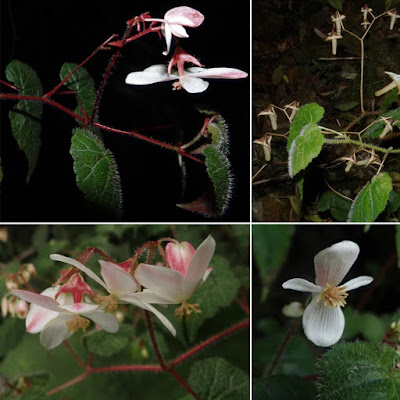[Most Recent Entries] [Calendar View]
Saturday, March 14th, 2020
| Time | Event | ||||
| 7:43a | [Botany • 2020] Begonia oleosa (Begoniaceae) • the First Species with Glandular Hairs in the Section Casparya
Abstract A new species of Begonia section Casparya from Colombia and Venezuela is described and illustrated. Begonia oleosa is closely related to Begonia toledana var. erubescens but differs mainly by its glandular trichomes. Keywords: Cucurbitales, northern Andes, taxonomy.
Begonia oleosa Jara, sp. nov. Diagnosis: This species can be distinguished from Begonia toledana var. erubescens L.B. Sm. & B.G. Schub. by the presence of glandular hairs, larger leaves (7.9−14.9 × 2.2−5.0 vs. 2.5−6.9 × 0.8−1.9 cm), and entire placentae (vs. bilamellated). Distribution and habitat.— This species has been found in the north of the Colombian Eastern Cordillera and the Venezuelan Cordillera de Mérida (States of Mérida and Táchira), at 2400–2900 m. It has been observed growing in semi-open and shaded areas on the side of routes and streams, sometimes on saturated soils, but also in dry and clayey soils, where the plants are smaller. The forests where Begonia oleosa grows are dominated by the genera Miconia, Palicourea, Clusia, and Schefflera, as well as the families Lauraceae, Ericaceae, Solanaceae and Asteraceae (e.g., Alvear et al., 2010; Galindo et al., 2003; Fig. 2A). Etymology.—The name is derived from the Latin “oleum”, referring to oil, in this case alluding to the oily nature of the surfaces of the leaves and stems resulting from secretions of the glandular hairs. Orlando Adolfo Jara-Muñoz. 2020. Begonia oleosa (Begoniaceae), the First Species with Glandular Hairs in the Section Casparya. Brittonia. DOI: 10.1007/s12228-020-09605-0 Resumen: Se describe e ilustra una nueva especie de Begonia, secciÆn Casparya de Colombia y Venezuela. Begonia oleosa estÄ cercanamente emparentada con Begonia toledana var. erubescens, pero difiere de esta principalmente por sus tricomas glandulares. | ||||
| 8:10a | [Botany • 2020] Goniothalamus sericeus (Annonaceae) • A New Species of Goniothalamus from the Western Ghats of Tamil Nadu, India
Abstract Goniothalamus sericeus is described as a new species from southern Western Ghats of India. The species shares some common morphological traits between G. keralensis E. S. S. Kumar, Shaju, P. E. Roy & Raj Kumar and G. wightii Hook.f. & Thomson, which are endemic to the southern Western Ghats. The photographs, illustrations and conservation status of the species are provided here for easy identification and to formulate better conservation and management strategies. Keyword: Annonaceae, Goniothalamus sericeus, India, Kanyakumari wildlife sanctuary, new species, Tamil Nadu Goniothalamus sericeus Sujana & Vadhyar, sp. nov. Goniothalamus sericeus is morphologically similar to G. wightii, which is also endemic to the southern Western Ghats. But differs from it in having smaller leaves (8–11 × 1.8–2.1 cm), deciduous sepals in fruits, rhomboid inner petals with densely sericeous abaxially and glabrous adaxially. The connective of the anther is papillate, rounded at apex and densely hairy. Ripen carpels are sessile, yellow in color with black strigose hairs basally. The new species is having some affinities with G. keralensis by having sessile monocarps and caducous sepals (Kumar et al., 2013). But G. keralensis differs from the new species by having much longer leaves (up to 28 cm), funnel shaped stigma and orange-brown ripen carpels. The distinguishing characters of G. sericeus from its allied taxa are given in Table 1. Distribution: So far known only from Kanyakumari wildlife sanctuary, Tamil Nadu, South India. Etymology: The specific epithet 'sericeus' refers to the presence of dense sericeous hairs on petals. Kanjiraparambil Arjunan Sujana and Rakesh Gopala Vadhyar. 2020. A New Species of Goniothalamus (Annonaceae) from the Western Ghats of Tamil Nadu, India. Taiwania. 65(2); 176-180. DOI: 10.6165/tai.2020.65.176 |
| << Previous Day |
2020/03/14 [Calendar] |
Next Day >> |










